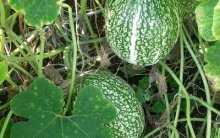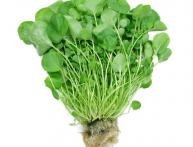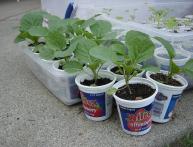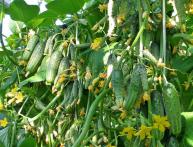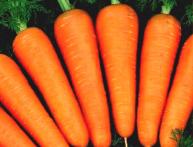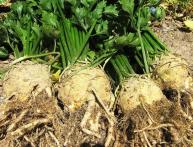Figoleaf pumpkin: cultivation, care, beneficial properties
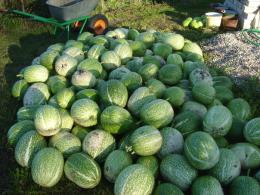
A classic vegetable in any gardener's garden is pumpkin. Hard-barked or large-fruited pumpkins are grown in household plots.
Many gardeners are starting to experiment and grow different types of crops. The figleaf pumpkin is considered to be less common, but very useful.
Vegetable culture has another name - phycephaly. It has many useful properties. Pumpkin is used both for preparing various dishes and for medicinal purposes.
Content:
- Description of phycephaly
- Beneficial properties of figoleaf pumpkin
- Features of growing phycephaly seeds
- How to grow figoleaf pumpkin seedlings
Description of phycephaly
The figleaf and black-seeded pumpkin is a perennial plant of the Cucurbitaceae family. Pumpkin leaves are similar to the leaves of a fig tree: large and petiolate, the lower ones slightly pitted, and the upper ones heart-shaped.
This is where the name of this agricultural crop comes from. The unusual shape of pumpkin leaves and small light spots on a green background look decorative and attractive.
The stems of the plant are pentagonal and reach a length of up to 25 cm. Phycephalia flowers are no different from any plant of the Pumpkin family and are orange or yellow in color.
The fruits of the figoleaf pumpkin resemble watermelons with their interesting patterns. They have an oblong, often curved shape. The pumpkin pulp is white and juicy, but not sweet. There are black seeds inside the pulp.
Figolifolia pumpkin is resistant to pathogenic soil fungi. Many gardeners graft pumpkins and other crops that are sensitive to root rot onto this type. Phycephalia does not interbreed with other types of pumpkin.
Beneficial properties of figoleaf pumpkin

Black seed pumpkin can be used not only for preparing a variety of dishes, but also for medicinal purposes. Ripe pumpkin fruits are very tasty and healthy. You can make jam from it, stew, pickle, fry, salt, and add to various salads.
In folk medicine, figoleaf pumpkin is used to treat the pancreas, diseases of the gastrointestinal tract, and the cardiovascular system. Pumpkin helps with diseases of the liver and kidneys, as well as the gall bladder.
Ficevalia improves insulin production and helps eliminate cholesterol from the body.
As a dietary food, black-seed pumpkin is introduced into the diet of patients with gastritis, ulcers, and colitis. To prepare collections and decoctions, all parts of the culture are used: roots, stems, leaves, seeds, fruits.
Pumpkin leaves contain many useful microelements: calcium, phosphorus, sodium, iron. A large amount of B vitamins are found in pumpkin seeds and fruits.
They are used in the treatment of arthritis and rheumatism. In addition, phycephalia helps with burns, psoriasis and other skin diseases.
Features of growing phycephaly seeds
The technology for growing figleaf pumpkin is almost no different from growing other types of this crop, but has its own characteristics. Pumpkin is quite unpretentious to the soil, loves watering and bright lighting. A prerequisite is a drainage layer.
Before planting, pumpkin planting material must be placed in water at room temperature for 3 days. Unlike other types of pumpkin crops, phycephalia is a cold-resistant plant and can withstand frosts down to -3 degrees.
Seeds germinate at a temperature of 10-12 degrees. This is the optimal temperature for planting planting material in open ground. Next, make small holes in the ground, add 3-5 kg of humus and 1.5 cups of ash.
Then mix well with the soil and you can begin the process of sowing seeds into the hole. Place 2-3 seeds in each hole to a depth of 3-4 cm. Mulch all holes with humus, peat or sawdust.
This will prevent the formation of a crust and improve the thermal conditions by several degrees at a depth of 5-10 cm.
For good growth and development of pumpkin, the temperature should be 20-25 degrees. The first shoots appear after 2 weeks from the moment of sowing.
The growing area must be windless and large in area. It is recommended to plant seeds in places where potatoes, cabbage, and onions were previously located. It is undesirable to use areas where other types of pumpkin crops grew.
How to grow figoleaf pumpkin seedlings

To get high and early pumpkin fruits, you can plant not only seeds, but also seedlings. The main components of the nutrient mixture are turf soil, peat and humus. Acidic soil must be limed.
Sow seeds in pots or small containers 2-3 weeks before planting. Water the pots well beforehand. As soon as the seeds have sprouted, they should be laid sprouts down and covered with a nutrient mixture.
As soon as the first shoots appear, the daytime temperature must be reduced to 17 degrees, and the night temperature to 12-14 degrees. Increased ventilation should also be carried out.
Seedlings need to be watered infrequently and in moderation. Before planting seedlings in the ground, they should be fed with manure, urea or mullein solution.
Planting seedlings in the ground must be done after the last frost. You can also plant it 2-3 weeks earlier, but in this case the seedlings must be covered with film. The depth should be about 12 cm. After planting, the seedlings must be watered.
If the soil is poor, then the holes should be made about 30 cm deeper. Put the soil mixture there, after adding mineral and organic fertilizers.
It is recommended to plant seedlings at a distance of one meter from each other.
After ripening, the pumpkin fruits are harvested in the fall, when the leaves of the plant disappear. To speed up the filling and ripening of fruits, you should pinch all growing points and cover them with soil. The fruits can be stored throughout the winter.
If you grow a crop following these simple rules and recommendations, you can get a good pumpkin harvest.
Figoleaf pumpkin: cultivation, care, beneficial properties
Interesting information about the vegetable garden


